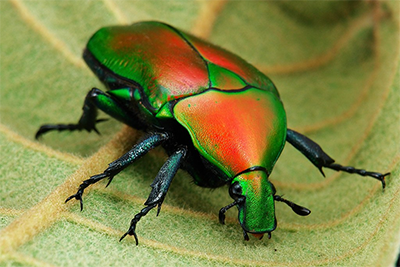| Jun 17, 2021 |
A biological blueprint for tough color
(Nanowerk News) The unique mechanical and optical properties found in the exoskeleton of a humble Asian beetle has the potential to offer a fascinating new insight into how to develop new, effective bio-inspired technologies.
|
|
Pioneering new research by a team of international scientists, including Professor Pete Vukusic from the University of Exeter, has revealed a distinctive, and previously unknown property within the carapace of the flower beetle - a member of the scarab beetle family.
|
 |
| The flower beetle Torynorrhina flammea.
|
|
The study showed that the beetle has small micropillars within the carapace - or the upper section of the exoskeleton - that give the insect both strength and flexibility to withstand damage very effectively.
|
|
Crucially, these micropillars are incorporated into highly regular layering in the exoskeleton that concurrently give the beetle an intensely bright metallic colour appearance.
|
|
For this new study, the scientists used sophisticated modelling techniques to determine which of the two functions - very high mechanical strength or conspicuously bright colour - were more important to the survival of the beetle.
|
|
They found that although these micropillars do create a highly enhanced toughness of the beetle shell, they were most beneficial for optimising the scattering of coloured light that generates its conspicuous appearance.
|
|
The research is published in Proceedings of the National Academy of Sciences ("Microstructural design for mechanical-optical multifunctionality in the exoskeleton of flower beetle Torynorrhina flammea").
|
|
Professor Vukusic, one of three leads of the research along with Professor Li at Virginia Tech and Professor Kolle at MIT, said: "The astonishing insights generated by this research have only been possible through close collaborative work between Virginia Tech, MIT, Harvard and Exeter, in labs that trailblaze the fields of materials, mechanics and optics. Our follow-up venture to make use of these bio-inspired principles will be an even more exciting journey."
|
|
The seeds of the pioneering research were sown more than 16 years ago as part of a short project created by Professor Vukusic in the Exeter undergraduate Physics labs. Those early tests and measurements, made by enthusiastic undergraduate students, revealed the possibility of intriguing multifunctionality.
|
|
The original students examined the form and structure of beetles' carapce to try to understand the simple origin of their colour. They noticed for the first time, however, the presence of strength-inducing micropillars.
|
|
Professor Vukusic ultimately carried these initial findings to collaborators Professor Ling Li at Virginia Tech and Professor Mathias Kolle at Harvard and then MIT who specialise in the materials sciences and applied optics. Using much more sophisticated measurement and modelling techniques, the combined research team were also to confirm the unique role played by the micropillars in enhancing the beetles' strength and toughness without compromising its intense metallic colour.
|
|
The results from the study could also help inspire a new generation of bio-inspired materials, as well as the more traditional evolutionary research.
|
|
By understanding which of the functions provides the greater benefit to these beetles, scientists can develop new techniques to replicate and reproduce the exoskeleton structure, while ensuring that it has brilliant colour appearance with highly effective strength and toughness.
|
|
Professor Vukusic added: "Such natural systems as these never fail to impress with the way in which they perform, be it optical, mechanical or in another area of function. The way in which their optical or mechanical properties appear highly tolerant of all manner of imperfections too, continues to offer lessons to us about scientific and technological avenues we absolutely should explore. There is exciting science ahead of us on this journey."
|

